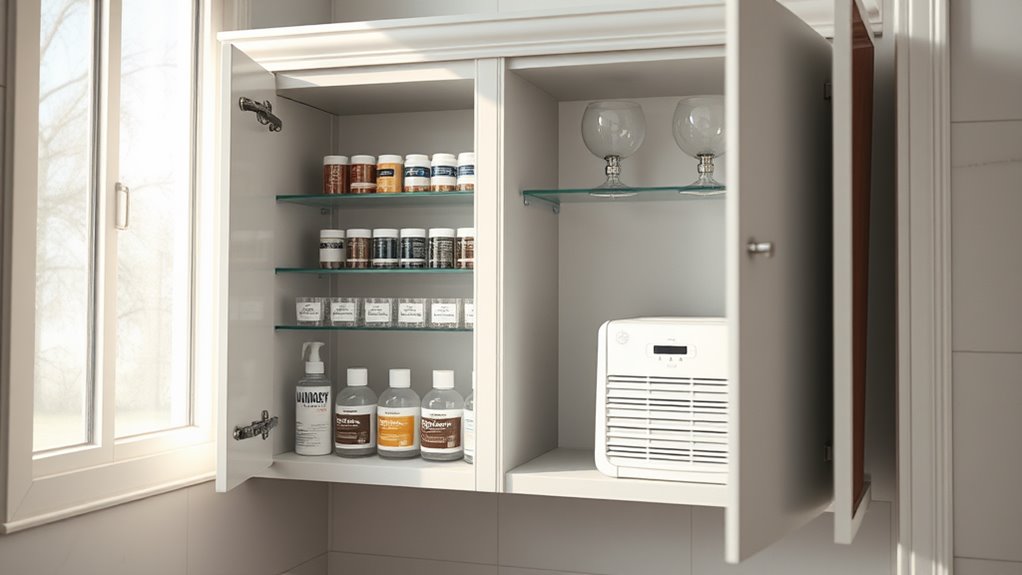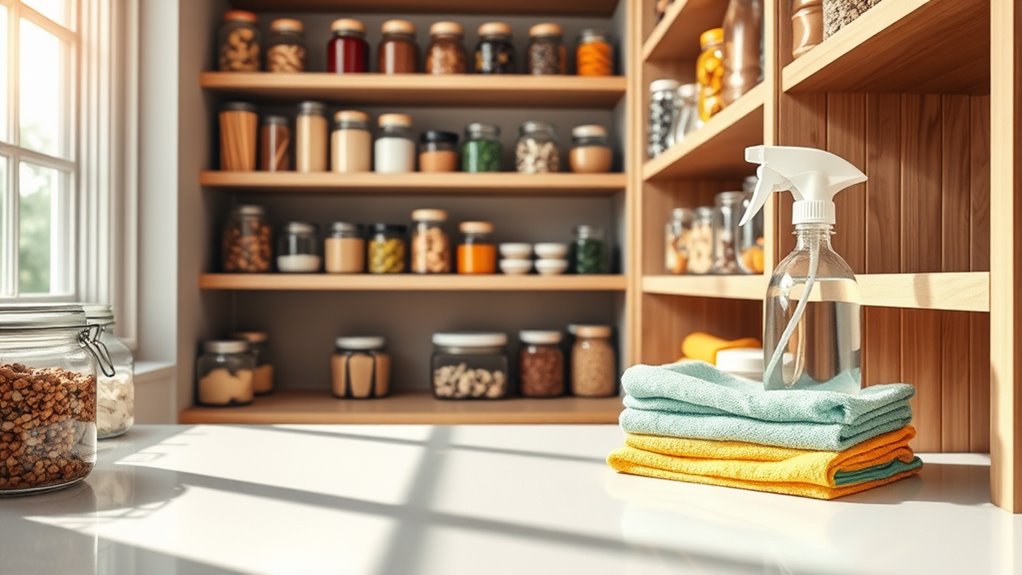This Natural Window Cleaner Gave Me the Best View Ever
This natural window cleaner will transform your view like never before! With simple ingredients like vinegar and distilled water, it leaves your glass spotless and sparkling. Plus, it’s eco-friendly and safe for your home. You’ll love the way it cuts through grime without harsh chemicals or streaks. Use a microfiber cloth for the best finish, and you’ll be amazed at the clarity. Stick around to discover more tips on enhancing your cleaning routine!
Key Takeaways
- The natural window cleaner’s ingredients, like vinegar and distilled water, ensure a streak-free shine for crystal-clear views.
- Utilizing a microfiber cloth enhances absorption and minimizes lint, resulting in pristine windows.
- Avoiding direct sunlight during cleaning prevents streaking and ensures optimal drying for a flawless finish.
- DIY cleaners are eco-friendly, reducing chemical exposure while providing effective cleaning power for a healthier environment.
- Regular use of natural ingredients promotes sustainability and cost savings compared to commercial cleaning products.
The Benefits of Using Natural Ingredients
Using natural ingredients for your window cleaning not only benefits your health but also helps the environment. By opting for a DIY window cleaner, you eliminate harmful chemicals that can linger in your home and seep into the ecosystem. Additionally, creating your own cleaner allows you to incorporate eco-friendly all-purpose cleaner methods that can be used for various surfaces around the home. This approach not only enhances your cleaning routine but also fosters sustainable cleaning practices that contribute to a healthier planet. Furthermore, using natural ingredients like vinegar as a base can also provide effective cleaning solutions for other household tasks. The use of natural ingredients ensures that your cleaning routine is both safe and effective.
Natural ingredients, like vinegar and baking soda, effectively break down grime without leaving toxic residues. You’ll find these alternatives are often more affordable and just as efficient as commercial products.
Plus, you’re reducing plastic waste by reusing containers instead of buying new bottles. As you master the art of creating your window cleaner, you’ll experience a clearer view and a sense of pride in making eco-friendly choices. Additionally, the process of making your own cleaner allows you to customize the formula to suit your specific cleaning needs, making it even more effective.
Your windows will sparkle, and you’ll know you’ve done your part for both your health and the planet.
Essential Ingredients for Your DIY Window Cleaner
Crafting your own window cleaner is simple when you know the essential ingredients to include. Start with distilled water, as it prevents streaks and mineral deposits. Additionally, using distilled water can significantly improve your cleaning results by minimizing impurities. For optimal cleaning, consider using eco-friendly all-purpose cleaner to complement your window cleaning routine.
Next, add white vinegar, a powerful natural degreaser that cuts through grime and enhances shine. Vinegar can also be used as a natural disinfectant to further sanitize surfaces in your home. For a fresh scent, incorporate a few drops of dish soap—this helps lift dirt without leaving residue. You might also consider essential oils, like lemon or lavender, for an aromatic touch. If you want to tackle tough spots, baking soda can be your ally; just sprinkle a bit on the glass before wiping. Additionally, using common kitchen ingredients can help you achieve sparkling results without harsh chemicals. Combining vinegar and baking soda creates an effective cleaning reaction that can tackle stubborn stains on various surfaces.
Step-by-Step Recipe for Homemade Window Cleaner
Now that you know the essential ingredients for your DIY window cleaner, it’s time to put them to use. You’ll follow a simple step-by-step recipe that makes cleaning your windows a breeze. Let’s explore the techniques you’ll use to guarantee a streak-free shine!
Essential Ingredients Needed
Whether you’re tackling streaky glass or dusty window sills, having the right ingredients for a homemade window cleaner makes all the difference. To create an effective solution, gather these essential ingredients:
| Ingredient | Purpose | Measurement |
|---|---|---|
| Vinegar | Cuts grease and grime | 1 cup |
| Distilled water | Prevents streaks | 1 cup |
| Essential oil | Adds fragrance | 5-10 drops |
Mix them in a spray bottle for best results. Vinegar acts as a powerful natural cleaner, while distilled water guarantees clarity. Adding essential oil not only makes your cleaner smell divine but also enhances its cleaning properties. With these ingredients, you’re well on your way to achieving crystal-clear windows.
Cleaning Techniques Explained
To achieve sparkling clean windows, you’ll want to follow a few straightforward cleaning techniques that maximize the effectiveness of your homemade window cleaner.
Start by mixing equal parts water and white vinegar in a spray bottle. Shake it gently to combine.
Before application, dust the windows with a microfiber cloth to eliminate dirt and debris.
Spray your solution generously on the glass, working from top to bottom to prevent streaking.
Use a squeegee to wipe away the cleaner, applying even pressure. For edges, you can use a soft cloth to catch any drips.
Finally, buff the glass with a clean, dry microfiber cloth for that crystal-clear finish.
With practice, you’ll master the art of window cleaning!
How to Effectively Use Your Natural Window Cleaner
Now that you’ve made your natural window cleaner, let’s get into how to use it effectively.
You’ll want to know the best ingredients for a streak-free shine, the right application techniques, and drying tips to finish the job perfectly. For optimal results, consider using eco-friendly ingredients that not only clean but also minimize environmental impact. Incorporating all-natural disinfectants into your cleaning routine can enhance the germ-killing power of your cleaner. Additionally, remember to regularly sanitize your surfaces using natural methods to maintain a hygienic environment. It’s important to note that many commercial cleaning products can damage surfaces, so opting for safer alternatives is a wise choice. To achieve the best results, utilize citrus peels in your cleaning routine, as they can help cut through grease and grime effectively.
With these tips, your windows will be sparkling clean in no time!
Best Ingredients to Use
What ingredients can transform your homemade window cleaner into an effective solution?
Mastering the art of window cleaning starts with the right components. Here’s a list of the best ingredients to elevate your cleaner:
-
White Vinegar: A powerful natural solvent that cuts through grime and streaks.
-
Water: Acts as a diluent, ensuring your solution isn’t too concentrated.
-
Cornstarch: Adds a gentle abrasive quality, perfect for scrubbing tough spots without scratching.
-
Essential Oils: Optional, but they provide a fresh scent and can enhance cleaning properties.
Combine these ingredients in the right ratios, and you’ll have a homemade window cleaner that not only shines but also keeps your windows spotless and streak-free.
Application Techniques Explained
Mastering the application of your natural window cleaner can make all the difference in achieving sparkling results.
To start, make certain your windows are shaded to prevent streaks caused by sunlight. Spray your cleaner generously, focusing on one section at a time. Use a microfiber cloth or a squeegee for best results—these materials minimize lint and enhance absorption.
When wiping, apply even pressure and work in a circular motion to lift dirt effectively. For corners and edges, consider using a soft-bristle brush or an old toothbrush. Remember to rinse your cloth frequently to avoid reapplying grime.
With these techniques, you’ll not only clean your windows but also transform your view into something truly spectacular. Enjoy the clarity!
Streak-Free Drying Tips
After applying your natural window cleaner, the next step is to guarantee a streak-free finish. Mastering this technique elevates your window-cleaning game.
Here are four effective drying tips to achieve that crystal-clear look:
-
Use a microfiber cloth****: It absorbs moisture better than regular cloths, reducing streaks.
-
Employ the right technique****: Wipe in a circular motion or a zigzag pattern to cover all areas evenly.
-
Avoid direct sunlight****: Cleaning in the shade prevents the cleaner from drying too quickly, which can lead to streaking.
-
Change cloths often: A dirty cloth can leave residue, so switch to a clean one to maintain clarity.
Comparing Natural Cleaners to Commercial Options
While many people swear by commercial window cleaners for their convenience and effectiveness, natural alternatives have gained popularity for their eco-friendliness and safety.
When you compare these options, you’ll notice that natural cleaners often use simple ingredients like vinegar and baking soda, making them less harsh on your surfaces and the environment. They may require a bit more elbow grease, but the satisfaction of using a cleaner you crafted yourself is unparalleled.
Commercial cleaners, on the other hand, might deliver quicker results due to their chemical formulations but can leave behind residues and strong odors.
Ultimately, your choice depends on your priorities: quick results or a commitment to using safer, more sustainable products in your home.
Environmental Impact of DIY vs. Store-Bought Cleaners
Choosing between DIY and store-bought cleaners not only affects your cleaning routine but also has significant environmental implications. You mightn’t realize how your choice impacts the planet.
Here are some factors to evaluate:
-
Ingredients: DIY cleaners typically use natural ingredients, reducing harmful chemical exposure.
-
Packaging: Store-bought cleaners often come in single-use plastic, contributing to waste.
-
Production: Commercial cleaners require energy for production and transportation, increasing carbon footprints.
-
Biodegradability: Many DIY options are biodegradable, while some store-bought cleaners can linger in ecosystems for years.
Cost Savings of Making Your Own Window Cleaner
Making your own window cleaner not only benefits the environment but also saves you money. Store-bought cleaners can be pricey, often costing several dollars for a single bottle.
By using simple ingredients like vinegar and water, you create an effective solution for a fraction of the cost. A gallon of vinegar might set you back just a couple of dollars, and it can yield multiple batches of cleaner.
Plus, you won’t have to deal with the constant repurchase of commercial products. Think about how those savings add up over time. Not only will you enjoy streak-free windows, but you’ll also feel empowered knowing you’re cutting costs while mastering the art of homemade cleaning solutions.
It’s a win-win!
Frequently Asked Questions
Can I Use This Cleaner on Tinted Windows?
You can use this cleaner on tinted windows, but always test in a small area first. It’s essential to guarantee it doesn’t damage the tint or affect its appearance. Keep your windows spotless and streak-free!
How Long Does the Homemade Window Cleaner Last?
Homemade window cleaner typically lasts about a week when stored in a cool, dark place. If you notice any separation or an off smell, it’s best to discard it and make a fresh batch.
Is This Cleaner Safe for Pets and Children?
Yes, this cleaner’s made from safe, natural ingredients, so it’s non-toxic for pets and children. You can use it without worry, ensuring a clean home environment while keeping your loved ones safe and healthy.
What Should I Do if the Cleaner Leaves Streaks?
If the cleaner leaves streaks, don’t worry! You can simply reapply it, using a microfiber cloth for a streak-free finish. Make sure to work in small sections for the best results and ideal clarity.
Can I Add Essential Oils for Fragrance?
Absolutely, you can add essential oils for fragrance! Just mix a few drops into your solution. It’ll not only enhance the scent but can also provide additional cleaning properties, making your cleaning experience even more enjoyable.



